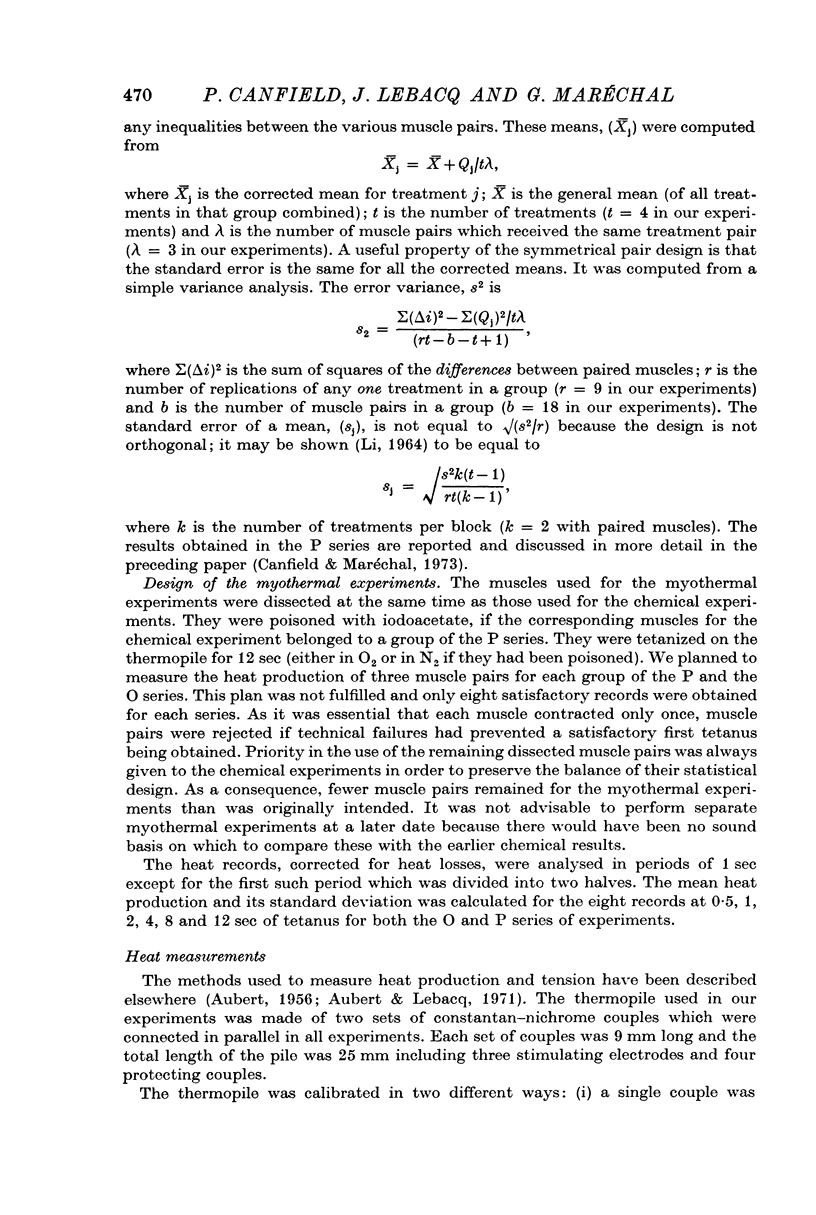Abstract
1. Changes in the concentrations of ATP, ADP, AMP, IMP, creatine and phosphorylcreatine (PC) have been measured in frog sartorius muscles after different periods of isometric stimulation at 20° C. The heat production was measured in parallel experiments with a thermopile of the Hill-Downing type.
2. Muscles were either in O2 and unpoisoned or in N2 and poisoned with iodoacetic acid to prevent aerobic and glycolytic recovery processes.
3. Poisoning did not appear to alter the heat production of these muscles and had little effect on the tension for up to 8 sec tetanus.
4. The break-down of high-energy phosphates (∼ P) during contraction was faster in the poisoned muscles. Normal muscles were thus able to resynthesize high energy phosphates during the contraction. The resynthesis began at its maximum rate; part of it was probably due to glycolytic activity.
5. During the first 2 sec of contraction (poisoned muscles), the only net reaction was an hydrolysis of PC, with an apparent enthalpy change of -8·3 kcal/mole. During longer contractions, the PC hydrolysis was accompanied by a net ATP hydrolysis and appearance of AMP and IMP.
6. For the first 2 sec of contraction in the poisoned muscles, the observed heat agreed with that expected from the observed chemical changes multiplied by their molar enthalpy changes. After 2 sec, the observed heat was greater than that expected. At 12 sec this excess was about 74 mcal/g. Possible explanations for this discrepancy are discussed.
Full text
PDF
















Selected References
These references are in PubMed. This may not be the complete list of references from this article.
- Aubert X., Lebacq J. The heat of shortening during the plateau of tetanic contraction and at the end of relaxation. J Physiol. 1971 Jul;216(1):181–200. doi: 10.1113/jphysiol.1971.sp009517. [DOI] [PMC free article] [PubMed] [Google Scholar]
- Canfield P., Maréchal G. Equilibrium of nucleotides in frog sartorius muscle during an isometric tetanus at 20 degrees C. J Physiol. 1973 Aug;232(3):453–466. doi: 10.1113/jphysiol.1973.sp010280. [DOI] [PMC free article] [PubMed] [Google Scholar]
- Gilbert C., Kretzschmar K. M., Wilkie D. R., Woledge R. C. Chemical change and energy output during muscular contraction. J Physiol. 1971 Oct;218(1):163–193. doi: 10.1113/jphysiol.1971.sp009609. [DOI] [PMC free article] [PubMed] [Google Scholar]
- HERMANS N. Recherches sur le métabolisme du muscle au cours de l'intoxication par l'acide monobromacétique. Arch Int Physiol Biochim. 1956 Mar;64(2):251–268. doi: 10.3109/13813455609145426. [DOI] [PubMed] [Google Scholar]
- Hartree W. The analysis of the initial heat production of muscle. J Physiol. 1931 Jun 6;72(1):1–26. doi: 10.1113/jphysiol.1931.sp002759. [DOI] [PMC free article] [PubMed] [Google Scholar]
- MARECHAL G., AUBERT X. Influence de la fatigue sur la thermogénèse du muscle strié. Arch Int Physiol Biochim. 1958 Feb;66(1):91–93. [PubMed] [Google Scholar]
- WILKIE D. R. Thermodynamics and the interpretation of biological heat measurements. Prog Biophys Mol Biol. 1960;10:259–298. [PubMed] [Google Scholar]
- WOLEDGE R. C. The thermoelastic effect of change of tension in active muscle. J Physiol. 1961 Jan;155:187–208. doi: 10.1113/jphysiol.1961.sp006622. [DOI] [PMC free article] [PubMed] [Google Scholar]
- Wilkie D. R. Heat work and phosphorylcreatine break-down in muscle. J Physiol. 1968 Mar;195(1):157–183. doi: 10.1113/jphysiol.1968.sp008453. [DOI] [PMC free article] [PubMed] [Google Scholar]


